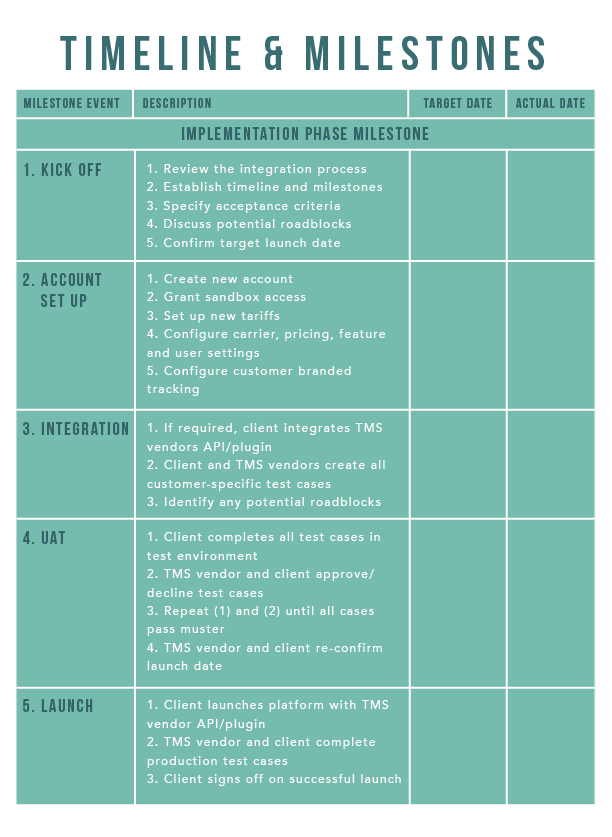Reduce TMS Implementation Times:
Get Up and Running in a Couple of Days or Weeks, Not Months
Legacy transportation management systems (TMS) are notorious for taking a year or longer to install and implement. It’s no wonder why only large companies have traditionally used them. The long installation and implementation time, in addition to the lack of immediate results, makes the purchase of TMS difficult to justify. Smaller and mid-sized companies cannot afford the staff, budget or time to devote to large-scale project management that a legacy TMS may require.
As TMS solutions have moved to the cloud, costs and implementation times have decreased and are now within reach for small and mid-sized companies. Advancements in technology have led to the advancement of TMS quality and capabilities. Today’s TMS customers benefit from:- Instant, accurate and visible rate information for hundreds of carriers and freight brokers
- Carrier and service routing
- Packing optimization
- Order fulfillment automation
- Multi-modal support
- Shipping document creation and printing (bills of lading, invoices, labels and internal documents)
- Real-time shipment tracking
And it’s all done within one web-based platform. With current cloud-based TMS solutions, companies no longer have to wait for a year. A modern TMS can be set up in a matter of days. Modern, cloud-based TMS setup is easy.
The Problem with Legacy
Legacy systems were not built with the internet in mind and were not able to easily integrate with a myriad of other business systems. A TMS today is able to work with many other software systems to make sure there’s an effective workflow process and to ensure company-wide visibility.
Cloud/SaaS Installation
One reason installation is much easier is because data is brought into TMS systems using these sources:
- API: Many cloud solutions are API-based products that can speak to your CRM, shopping cart, OMS and/or ERP
- The Internet of Things: IoT provides real-time data, which improves shipment tracking
- Plug-ins: Plug-ins for popular eCommerce platforms, WMS, ERP, CRM and accounting platforms speed setup and facilitate real-time data exchange
Here's a look at all of our compatible technology partners.
Seamless Implementation & Updates
Cloud-based transportation management systems require no down time to implement. Testing is done offline pre-launch, using applicable customer data to ensure that the right requirements are met. Users are frequently trained before the system goes live, and given the nature of the modern interface, it is simple to understand.
After implementation, software is constantly tweaked and improved. With the cloud model, customers have less to worry about.
- There are no patches to install manually
- There are no buttons to push to start an update online
- Customers don’t have to install the updates; they’re automatically handled by the provider
- Software updates work while you’re sleeping so there is essentially no wait time
- New features are rolled out over time without additional cost
Cost Savings
TMS efficiencies generate massive cost savings, making it imperative to install quickly once a decision has been made. Small and mid-sized businesses can take advantage of the many benefits traditionally leveraged only by their large competitors, like the mobile functionality and accessibility that is offered through cloud-based systems.
The implementation process is not as lengthy as it once was. Now that TMS systems are within reach for companies of all sizes and industries, TMS is gaining wider adoption. Transportation management systems provide shipper and rate visibility, increased warehouse efficiency, shipment tracking and substantially lower shipping costs.

Cloud TMS Setup and Configuration
New Customer Implementation is the process by which the TMS vendor installs the new software solution, while working with the customer’s technical and operational team. From a bird’s eye view, the implementation and configuration process follows five simple steps:
TMS Implementation Steps
Step 1: Kick-off
Internal Kick-off
To start the process, the TMS sales representative prequalifies the new customer to ensure they’re a proper match for the TMS product/company. The customer should be briefed on how the TMS works and should review the steps for a successful implementation. The sales representative works to understand the customer and their needs and passes that information along to the Product and Customer Success teams. The sales representative understands the customer’s contract terms, shipping profile, qualification notes, client contact(s), desired and committed integration timeframes and professional service needs, among any other specific needs.
The Customer Success and Sales teams want to ensure that:
- The Customer Success team has a clear understanding of customer expectations
- The Customer Success team is fully aware of deliverables required through professional services
New customers are assigned to an Account Manager, who sets up a kick-off call with all the involved parties.
Kick-Off Call
The kick-off call ensures that the customer and the Customer Success team are on the same page, and everyone understands the expectations. In this kick-off call, the customer and customer success team work to:
- Get a clear understanding of the implementation process
- Confirm that the company’s solutions meet the customer’s needs
- Set timelines and key milestones that lead to a successful implementation
- Introduce the customer to their primary point of contact
- Introduce the Account Manager to the key points of contact on the customer’s team
Step 2: Account Set-Up
After the kick-off call, the Account Manager sets up the customer’s account and the following:
- New account creation and configuration
- Establish carrier/broker access
- Account Manager sends:
- Technical Documentation
- Credentials and test API Key
- Certification documentation
- Sets up recurring weekly milestone check-ins
- Schedules technical follow-up with the implementation team
Step 3: Development and Integration
Development covers the time where the customer is integrating the TMS product into their internal system(s). The customer reviews technical documentation and asks any questions, and ultimately prepares their system to undergo the vendor’s Certification process. During this phase, the goals might be:
- Ensure that the customer’s planned implementation supports their prerequisites
- Supply the customer’s developers with appropriate documentation and resources
- Answer all the customer’s technical questions
- Ensure that the customer’s developers properly integrate on the first try
- Fully prepare the customer’s developers for Certification
Step 4: User Acceptance Testing
The User Acceptance Testing (UAT) and Certification phase ensures that the customer’s integration successfully meets the requirements specified in the pre-implementation phase and kick-off call. Here, the customer runs through a series of tests as laid out in the Certification process. It includes submitting a small parcel quote, submitting an LTL quote, booking a shipment, generating a receipt and checking shipment status, among other things. The goals of this phase include:
- Successfully complete Certification
- Understand any necessary changes before the system goes live
- Approve the customer’s move to the production environment
Step 5: Launch
And finally, it’s almost launch time! As part of this last phase, the implementation manager coordinates the testing day with the customer, then reviews and validates all the test scripts. If all is in order, the implementation manager and customer sign off on Certification and schedule the launch date. The official launch is when the customer deploys the TMS platform into their production environment for active use.
The customer is assigned a Customer Support Specialist, who works with the customer for any additional business requirements and open issues.

That’s it! It’s a lot easier than implementing a legacy system. For more information, check out some of our case studies on how TMS works with various size companies.
Still have more questions regarding implementing a TMS? Speak with a ShipHawk expert today!


kraked.jpg?width=598&name=AdobeStock_163019636%20(1)kraked.jpg)